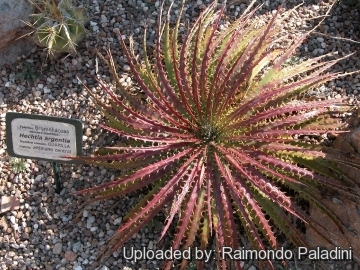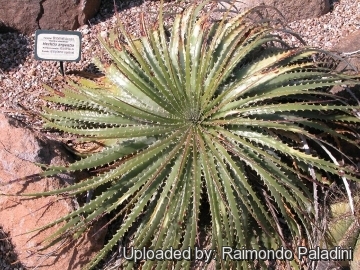




Your support is critical to our success.

Habit at El Charco del Ingenio (Jardín Botánico y Reserva Natural). San Miguel de Allende, Guanajuato, Mexixo.
Origin and Habitat: Hechtia argenteaSN|32978]]SN|32978]] was discovered in a Mexican canyon in 1860, so is well over 150 years old, but remained for a long time unknown from wild populations and known only from the type specimen as well as of cultivated plants at Kew Gardens. Recently thousands of plants have been found growing in a single canyon system in the Barranca de Tolimán, northwest of Zimapán in southwestern Hidalgo, Mexico.
Elevation range: Unknown.
Habitat and ecology: Hechtia argenteaSN|32978]]SN|32978]] grow nestled in the step limestone rock overlooking the canyon bottom together with Agave xylonacanthaSN|208]]SN|208]], Ferocactus echidneSN|1532]]SN|1690]], Ferocactus glaucescensSN|1690]]SN|1532]], Mammillaria geminispinaSN|14012]], Mammillaria geminispinaSN|14012]], Echeveria tolimanensis, Astrophytum ornatumSN|3660]]SN|3660]] and Yucca queretaroensisSN|32977]]SN|32977]].
Synonyms:
- Hechtia argentea (B.S.Williams) Baker
- Dyckia argentea B.S.Williams
ENGLISH: Silver Queen, Silver Star
Description: Hechtia argenteaSN|32978]]SN|32978]] is a terrestrial bromeliad with wide, symmetrical, rosettes that spread out beautifully and make a tall spike of orange flowers. The numerous, long, recurving leaves are green but are covered with white scales, which give the plant a silvery appearance. Even though spiny, Hechtia argenteaSN|32978]]SN|32978]] is so spectacular (probably the most spectacular species in the genus) with its dense rosette of leaves, 2.5 cm wide and up to 60 cm long, that it is worth a trial. Sadly young plants from the seed have green leaves with very little of the glaucous white bloom on them and fail to possess H. argentea's handsome and distinctive silver leaves.
Leaves: Numerous (up to a hundred), succulent, recurving, pale green, tapering to a point and heavily toothed, with silvery margins. The silvery coating on the leaves develops with age, but is easily washed or rubbed off, soiling the appearance. When I grow these plants from the seed, the young ones have green leaves with very little of the glaucous white bloom on them, but frequently having purplish red on the tips. As the plants age, the develop more of the glaucous white bloom characteristic of the mature plants.
Inflorescences: The long inflorescence carries clusters of white flowers on short spurs. Several flower stalks are produced by a mature rosette.
Bibliography: Major references and further lectures
1) The Garden: An Illustrated Weekly Journal of Gardening in All Its Branches, Volume 8 1875
2) Awesome Agave Blog “The Awe Inspiring Barranca de Tolimán” Starr Nursery. <http://starr-nursery.com/awe-inspiring-barranca-de-toliman/>
3) Phil Clark “The Gray Eminence of Kew Gardens” Bulletin Field Museum of Natural History, Volume 40, Number 7 January 1969
4) R.J. Hodgkiss 2016 “Bromeliaceae de Jussieu 1789” web 26 May 2016 <http://succulent-plant.com/families/bromeliaceae.html>

At El Charco del Ingenio (Jardín Botánico y Reserva Natural). San Miguel de Allende, Guanajuato, Mexixo. Photo by: Raimondo Paladini

At El Charco del Ingenio (Jardín Botánico y Reserva Natural). San Miguel de Allende, Guanajuato, Mexixo. Photo by: Raimondo Paladini
Cultivation and Propagation: It is a compact and carefree slow growing bromeliad particularly ornamental most of the year.
Growing substrate: This bromeliad needs a well drained soil mix comprising equal parts of well rotted compost, coarse river sand (or pumice) and loam and can remain in the same position for many years.
Watering: It enjoys regular moisture, once per week during the summer growing period, but reduce watering in winter to once every two or four weeks, but it’s very tough and drought tolerant. Requires complete and perfect drainage. Give it excellent drainage.
Feeding: Apply a very weak liquid feed every month or so over the growing season and a mild solutions (one-quartet strength) of foliar fertilizer at 3-month intervals to both garden and container plants.
Hardiness: USDA Zones: 9-11, Hardy to -6° C. North of Zone 9, this bromeliad is grown in containers that must be overwintered indoors.
Pest & diseases: No serious insect or disease problems. Watch for aphids and scale. Mealybugs infestations are also a frequent problem. Rot may develop if soil is kept too moist.
Tip: Remove old leaves from plant base and dead flower spikes only. Remove older plant crown when it begins to fade. Container grown plants should be re-potted every other year for good growth when new growth starts in the spring, but only need to be divided every seven or eight years when flowering performance starts to diminish.
Warning: Plant has spines or sharp edges that deter some gardeners; use extreme caution when handling.
Use: In warm and temperate climates grow it as a groundcover or accent in desert or alpine gardens, mixed borders, courtyard gardens, raised beds and rockeries. The plant makes a good potted plant and can also be cultivated as a house plant or patio container filler.
Propagation: It is propagated by division of offsets and from seed. The offsets can be detached and repotted when they have reached the dimension of one third of the mother plant. Be sure to provide high humidity for a month after propagating the offsets. Fresh seed germinates in as little as 14 days from sowing. Remove seeds from inflorescence and lay them uncovered on a bed of of pumice grit; keep constantly but moderately moist. Starting from the seed, 2-4 years are needed for the blossoming, whilst at least 2 years are needed by division.
| Your Actions | |
|---|---|
| Back to Hechtia index | |
| Back to Bromeliaceae index | |
 |
Back to Bromeliads Encyclopedia index |
Privacy stantement - Terms and conditions - How to cite - About us - Feedback - Donate


